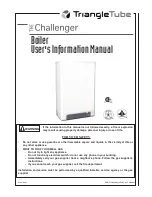
bypass device mus t alway s be
perfectly closed.
WOOD LOAD INSPECTION LIGHT
When the boiler is turned on, the
wood load inspection light (pos. 10)
r emains on until a cer t ain
temperature value is reached (about
150°C), after which it turns off and
when the wood has been loaded, you
can close the door. The fan starts
operating automatically. When the
light comes on again, this means that
the activation was not per formed
correctly and therefore you need to
r eopen t he door and r epeat t he
switch-on procedure.
If instead the light turns on again
(about 115°C) after a few hours of
operation, this means there is no
wood lef t and that the equipment
needs to be loaded again.
RESETTING THE
SAFETY THERMOSTAT
The control to reset the boiler's safety
thermostat is located at the front of
the instruments panel.
The thermostat (pos. 1) resets the
operation of the wood boiler.
There are no indicator lights to report
when the safety thermostat has been
triggered, as this is indicated by the
boiler thermometer (T>110°C) and the
fact that the fan stops. To restore
operating conditions:
- Wait for the temperature in the
boiler to drop below 100°C.
- Remove t he cap of t he saf e ty
thermostat.
- Press the manual reset stem.
SUMM/WINT DIVERTER AND
APPLICATION OF THE STORAGE TANK
THERMOSTAT
The summ/wint diverter (pos. 9) and
the application of the storage tank
thermostat (pos. 4) must be used
when the boiler is connected to a
DHW storage tank.
FAN SPEED DIVERTER
With the button of the diverter (pos.
7) pushed down and set to MAX, the
boiler operates at full power. With the
button set to MIN, the boiler operates
at t he minimum power, t her eby
extending how long the load will last.
FUSE
General 2.5 AT fuse (pos. 6).
TURNING OFF THE BOILER
If the boiler is temporarily turned off at
weekends, for short holidays or with
outdoor temperatures above “zero”,
press the main switch (pos. 8) and
take out the ash from the combustion
chamber.
If the equipment is not used for an
extended period of time, carry out the
steps below:
- Set the main switch pos.8 and the
master switch on the control panel
to “off"
- Disconnect the power plug.
- Close the shut-of f valves of the
water system
- Take out the ash and clean the
drying/gasification and combustion
chambers.
- Consider whe t her y ou should
cont act qualif ied t echnical
personnel for more comprehensive
cleaning.
WARNINGS: If there is a risk of
fr ost, emp ty the sys t em or add
suitable antifreeze liquids.
5.4
STARTING UP THE BOILER
After adjusting the combustion air as
indicated in
5.5
, close the bottom
door and power on the panel. The first
star t-up of the new boiler may be
tricky due to the damp refractory
material. We therefore recommend
you definitely open the primary air and
reduce the secondary air.
Open the bypass device and the top
loading door. Place some thin and dry
wood on the main stone, on top of
t he def lect or, and arr ange it
crosswise. Use highly flammable
material, avoid large and square
pieces.
Use some t hin shee ts of paper
(newspaper or similar) and light the
wood: you can also use lighting cubes
commonly available on the market.
Almost close the door and wait a few
minutes for the fire to light up and
pr oduce ember s (about 5 - 10
minutes). After a few minutes, if by
looking though the hole of the bottom
door you see that the flame inversion
process is starting, add bigger pieces
of wood.
Once the wood loading inspection
light turns off (10 fig. 8), close the
top door and the bypass device.
IMPORTANT: during operation, the
bypass device mus t alway s be
perfectly closed.
The length of the wood must be:
a) 33 cm (+ 1 cm, - 4 cm)
for the PIROEMME 4 model
b) 50 cm (+ 1 cm, - 4 cm)
for PIROEMME?5 models
c) 60 cm (+ 1 cm, - 4 cm)
for PIROEMME?6 models
d) 70 cm (+ 1 cm, - 4 cm)
for the PIROEMME 7 model
You are strictly required to follow
these measurements.
As to produce a good combustion it is
essential to have an even descent of
the wood, it is necessary to ensure
t hat t he lengt h of t he pieces
introduced, their shape and how they
are loaded do not prevent the fuel
from going down regularly. The pieces
must be arranged longitudinally and
horizontally.
None of the pieces must be tilted or
placed crosswise.
After detecting the flame inversion,
you can go ahead and add more wood
(bear in mind that the indications of
the adjustment table of the primary
and secondary air are only meant as
an indication).
5.4.1
Adding more wood
Before adding more wood, use up as
much as possible of the previous load
of wood.
Additional wood can be loaded when
the layer of embers in the storage
area is about 5-10 cm thick. Slowly
open the top loading door.
Use logs whose length is in line with
the values indicated in the previous
paragraph.
Arrange the new load of wood as
indicated above.
Fig. 9
17
ENG
ES
















































